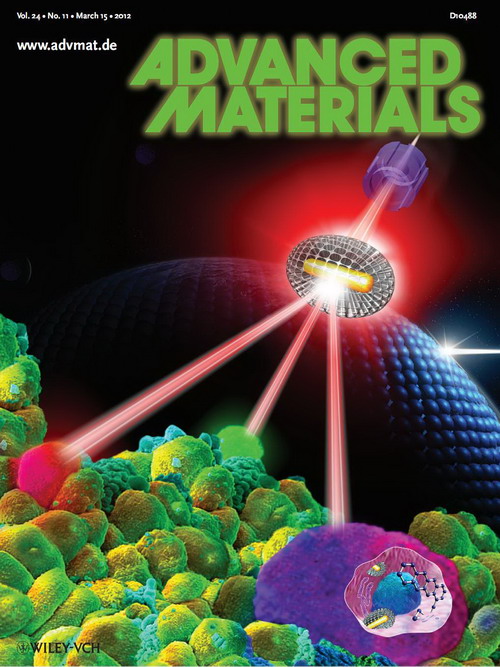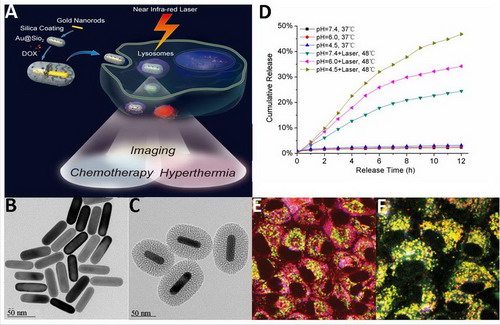Due to their unique optical properties and favorable biocompatibility, gold nanostructures (AuNSs), such as gold nanorods (AuNRs) and nanoshells, are being actively studied for biomedical applications. At National Center for Nanoscience and Technology (NCNST) of China, Professor Chunying Chen and Professor Xiaochun Wu’s groups have been working closely on the biological effects and safety of AuNRs, and exploring their applications.
Although they have been demonstrated to be promising imaging agents, AuNRs only have limited specific surface area and are not appropriate to be used as an efficient carrier for drug delivery. To solve this problem, the two groups have recently fabricated mesoporous silica-coated gold nanorods (Au@SiO2) and developed them as a versatile platform for imaging, chemotherapeutics, and hyperthermia. The report has been published online by Advanced Materials (http://onlinelibrary.wiley.com/doi/10.1002/adma.v24.11/issuetoc, selected as the cover image of Issue 11, 2012 , Figure 1).

Figure 1. The front cover of Advanced Materials, Issue 11, 2012.
In this report, two-photon imaging (TPI), is employed to visualize the intracellular colocalization of Au@SiO2 with DOX and some cellular compartments. Near infra-red (NIR) laser irradiation at a low intensity is used to enhance drug release from DOX-loaded Au@SiO2 (Au@SiO2–DOX) for chemotherapy, while at higher irradiation intensity it also triggers hyperthermia of the AuNRs. The Au@SiO2 platform thus keeps both the unique functions of mesoporous silica nanoparticles and gold nanorods, and also provides a new functionality: light controlled drug release. (Figure 2)

Figure 2. (A) TOC image of the report; TEM image of (B) AuNRs and (C) Au@SiO2; (D) DOX release profiles from Au@SiO2–DOX with and without NIR laser irradiation at different pHs; (E, F) Intracellular localization of DOX (red) and Au@SiO2 (blue) with organelle-specific probes including Lyso-Tracker (green) and Mito-Tracker (green) using two-photon confocal microscope.
With both the unique functions of mesoporous silica nanoparticles and gold nanorods, the new Au@SiO2 platform could have wide potential applications in cancer theranostics. A reviewer of Advanced Materials said: “The combination of mesoporous silica as a drug payload and gold nanorods as a heating device will provide us lots of possibilities in development of multimodal therapeautic technique in the next generation.” Development of such multifunctional theranostic systems with individual functions acting in a coordinated way is critical to optimize therapeutic efficacy and safety of therapeutic regimes, and could provide more opportunities for on-demand therapy and pave the road toward personalized medicine.
Due to their unique optical properties and favorable biocompatibility, gold nanostructures (AuNSs), such as gold nanorods (AuNRs) and nanoshells, are being actively studied for biomedical applications. At National Center for Nanoscience and Technology (NCNST) of China, Professor Chunying Chen and Professor Xiaochun Wu’s groups have been working closely on the biological effects and safety of AuNRs, and exploring their applications.
Although they have been demonstrated to be promising imaging agents, AuNRs only have limited specific surface area and are not appropriate to be used as an efficient carrier for drug delivery. To solve this problem, the two groups have recently fabricated mesoporous silica-coated gold nanorods (Au@SiO2) and developed them as a versatile platform for imaging, chemotherapeutics, and hyperthermia. The report has been published online by Advanced Materials (http://onlinelibrary.wiley.com/doi/10.1002/adma.v24.11/issuetoc, selected as the cover image of Issue 11, 2012 , Figure 1).

Figure 1. The front cover of Advanced Materials, Issue 11, 2012.
In this report, two-photon imaging (TPI), is employed to visualize the intracellular colocalization of Au@SiO2 with DOX and some cellular compartments. Near infra-red (NIR) laser irradiation at a low intensity is used to enhance drug release from DOX-loaded Au@SiO2 (Au@SiO2–DOX) for chemotherapy, while at higher irradiation intensity it also triggers hyperthermia of the AuNRs. The Au@SiO2 platform thus keeps both the unique functions of mesoporous silica nanoparticles and gold nanorods, and also provides a new functionality: light controlled drug release. (Figure 2)

Figure 2. (A) TOC image of the report; TEM image of (B) AuNRs and (C) Au@SiO2; (D) DOX release profiles from Au@SiO2–DOX with and without NIR laser irradiation at different pHs; (E, F) Intracellular localization of DOX (red) and Au@SiO2 (blue) with organelle-specific probes including Lyso-Tracker (green) and Mito-Tracker (green) using two-photon confocal microscope.
With both the unique functions of mesoporous silica nanoparticles and gold nanorods, the new Au@SiO2 platform could have wide potential applications in cancer theranostics. A reviewer of Advanced Materials said: “The combination of mesoporous silica as a drug payload and gold nanorods as a heating device will provide us lots of possibilities in development of multimodal therapeautic technique in the next generation.” Development of such multifunctional theranostic systems with individual functions acting in a coordinated way is critical to optimize therapeutic efficacy and safety of therapeutic regimes, and could provide more opportunities for on-demand therapy and pave the road toward personalized medicine.
 Close Page
Close Page- Text Size: A A A
 Printer Friendly
Printer Friendly
